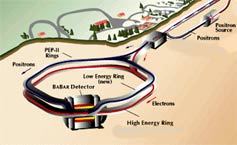
Handy Links
SLAC News Center
SLAC Today
- Subscribe
- Archives: Feb 2006-May 20, 2011
- Archives: May 23, 2011 and later
- Submit Feedback or Story Ideas
- About SLAC Today
SLAC News
Lab News
- Interactions
- Lightsources.org
- ILC NewsLine
- Int'l Science Grid This Week
- Fermilab Today
- Berkeley Lab News
- @brookhaven TODAY
- DOE Pulse
- CERN Courier
- DESY inForm
- US / LHC
SLAC Links
- Emergency
- Safety
- Policy Repository
- Site Entry Form

- Site Maps
- M & O Review
- Computing Status & Calendar
- SLAC Colloquium
- SLACspeak
- SLACspace
- SLAC Logo
- Café Menu
- Flea Market
- Web E-mail
- Marguerite Shuttle
- Discount Commuter Passes
-
Award Reporting Form
- SPIRES
- SciDoc
- Activity Groups
- Library
Stanford
Around the Bay
B Factory Run 5 for the Record Books
 The PEP-II collider and BaBar detector finished Run 5 on August 17 with flourish, showing great promise for the next run. The day before saw many performance records fall by the wayside and long-term goals achieved. The record day was a fitting culmination for 17 months of nearly continuous operation of the B Factory.
The PEP-II collider and BaBar detector finished Run 5 on August 17 with flourish, showing great promise for the next run. The day before saw many performance records fall by the wayside and long-term goals achieved. The record day was a fitting culmination for 17 months of nearly continuous operation of the B Factory.
Ultimately, physics from BaBar is driven by the number of B-anti-B pairs produced in the PEP-II collider. It takes a billion B pairs to produce just a handful of the most interesting rare decays. The rate of B particle production is dependent on luminosity, or how tightly packed the particles in the beam are when they collide.
The PEP-II team magnificently satisfied this voracious appetite for more B particles during Run 5. They made significant improvements to luminosity in three different ways: by squeezing the circulating electron and positron bunches harder to produce a smaller transverse cross section, by making them shorter along the beam direction, and by putting more charge in each one.
Last Thursday's all-time record peak luminosity, 12.07 x 1033 cm-2 s-1, exceeds the original design for the machine by a factor of four. This was one of the main goals for Run 5, and it was achieved with 20 percent lower beam currents than it took for the previous record in October 2005. "The difference was a systematic program to study and improve the beam optics for the machine, together with a lot of ingenious machine tuning," said Uli Wienands, Accelerator Division Deputy for Ring Operations.
Accumulating a large sample of B pairs depends not only on improvements to peak luminosity but also on "factory-like" delivery over days, weeks, and months. Overall, the data sample delivered to BaBar rose by 60 percent to 410 inverse femtobarns (fb-1) with this run. The best seven-day period saw an integrated luminosity of 5.4 fb-1 delivered, more than 20 percent better than Run 4, while the best 30-day period improved 16 percent to 19.3 fb-1. New records were also set for best shift, best three shifts, best day, best week, and highest beam currents for both electron and positron rings.
Running complex accelerator and detector systems this well 24 hours a day requires constant attention, as well as fast reaction to occasional outages. The dedication of the accelerator division staff and support services was a key factor in integrating data.
Over 17 month run, we encountered some unusual operational interruptions, a few of which proved challenging. A fallen tree took out the main power lines to SLAC for several days in May 2005, causing a site-wide power outage. When luminosity improvements from shortening the bunch lengths caused failures in the beam position instrumentation, repairs were quickly completed. The most challenging period was in January-March 2006, when an intermittent arcing problem developed in a unique piece of the vacuum system buried at the front of the BaBar detector. Careful detective work by PEP-II and BaBar, combined with ingenuity and planning, overcame the problem.
"The enthusiasm and dedication of the accelerator staff and operations support personnel has been phenomenal throughout Run 5," said John Seeman, Assistant Director for PEP-II and Linac Accelerator Systems. "The many luminosity records set in the last few months have been the result of a real team effort between accelerator staff, central support services, and BaBar."
With the end of Run 5, PEP-II and BaBar have now moved directly into an intense four-month period of upgrades intended to boost peak luminosity a further 70 percent. "The recently completed B Factory run, a phenomenal success story, reflects the tremendous ingenuity, dedication, and world-class expertise of the PEP-II and BaBar team," said SLAC Director Jonathan Dorfan.
See the PEP-II luminosity records here (pdf).
—David MacFarlane
SLAC Today, August 29, 2006
Above image: The PEP-II Ring. (Click on image for larger version, SLAC only.)